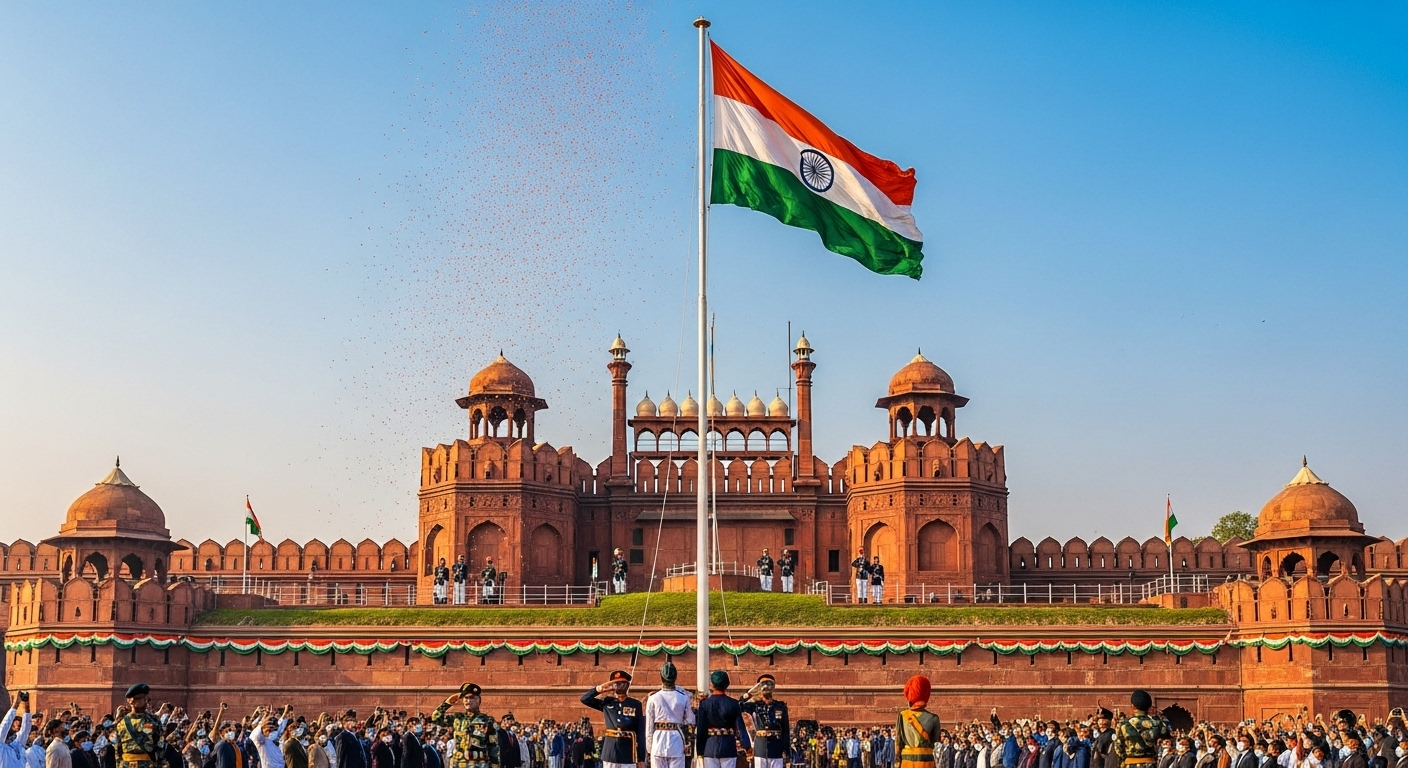
Introduction – Celebrating India’s Independence Day
Independence Day of India, celebrated on August 15, is one of the most sacred and powerful dates in Indian history. It marks the end of British colonial rule and the dawn of a free, sovereign, and democratic nation. Each year, millions of Indians come together to remember the sacrifices of our freedom fighters, rejoice in our nation’s progress, and reflect on the responsibilities that come with freedom.
The Dark Era of British Rule in India
India was under British rule for nearly two centuries, beginning with the East India Company’s arrival in 1600s and culminating in full control by the British Crown after the 1857 revolt. During this period:
- Indian industries were destroyed.
- Local rulers were dethroned.
- Heavy taxes and exploitation left people impoverished.
- Cultural and religious suppression spread widely.
The British controlled politics, economy, military, and education, and the spirit of India was constantly under siege.
Birth of the Freedom Movement
Despite the oppression, India did not remain silent. A strong wave of resistance and revolution began in the 19th century and gradually evolved into a mass movement.
Key Phases in the Freedom Struggle:
- 1857 – First War of Independence: Led by heroes like Mangal Pandey, Rani Lakshmibai, and Bahadur Shah Zafar, this revolt was the first spark against British dominance.
- 1905 – Swadeshi Movement: Boycotting British goods and promoting Indian-made products gained momentum.
- 1919 – Jallianwala Bagh Massacre: British troops opened fire on peaceful protesters, killing hundreds. This tragedy united Indians in rage and resolve.
- 1920–22 – Non-Cooperation Movement: Led by Mahatma Gandhi, this was a non-violent protest encouraging Indians to leave British institutions.
- 1930 – Salt March (Dandi March): Gandhi walked 240 miles to produce salt, defying British monopoly laws.
- 1942 – Quit India Movement: A final call for British withdrawal from India. Mass arrests and violent clashes followed.
Freedom Fighters Who Inspired Generations
Mahatma Gandhi – The Apostle of Non-Violence
Mahatma Gandhi revolutionized the freedom movement with Satyagraha (truth force) and Ahimsa (non-violence). His leadership turned India’s freedom struggle into a mass movement involving people from all walks of life.
Netaji Subhas Chandra Bose – The Warrior Patriot
Founder of the Indian National Army (INA), Netaji believed in armed resistance. His famous line “Give me blood, and I will give you freedom” still echoes as a call to action and bravery.
Bhagat Singh – The Young Martyr
Executed at the age of 23, Bhagat Singh’s revolutionary ideas, courage, and sacrifice made him an icon. His resistance was loud, bold, and deeply intellectual.
Dr. B.R. Ambedkar, Sardar Patel, Jawaharlal Nehru, Lala Lajpat Rai, Bal Gangadhar Tilak, Annie Besant—each played a vital role in uniting Indians under the umbrella of freedom.
August 15, 1947 – The Birth of a Nation
After relentless struggle and negotiations, India finally gained independence on August 15, 1947. Sadly, this historic moment also witnessed the partition of India and Pakistan, leading to the displacement of millions and communal violence.
Nehru’s “Tryst with Destiny” Speech
On the midnight of independence, Pandit Jawaharlal Nehru, India’s first Prime Minister, delivered a historic speech that began:
“At the stroke of the midnight hour, when the world sleeps, India will awake to life and freedom.”
This speech symbolized a new beginning, the hope of a better future, and the end of centuries of domination.

How Independence Day is Celebrated Across India
Flag Hoisting and National Anthem
Every year, the Prime Minister hoists the national flag at the Red Fort in Delhi. This is followed by a guard of honor, address to the nation, and cultural performances that reflect India’s unity in diversity.
Parades, Patriotic Events, and Decorations
Government institutions, schools, colleges, and residential colonies organize parades, cultural programs, and competitions. Streets are adorned with tricolor decorations, and patriotic songs echo everywhere.
Kite Flying – A Unique Tradition
In cities like Delhi, kite flying is symbolic of freedom. The skies are dotted with vibrant kites—often in saffron, white, and green—representing the Indian flag.
The Significance of Independence Day Today
Remembering the Sacrifices
Independence Day is not just a celebration but a remembrance of those who gave up their lives so that we could breathe free air. It’s a tribute to the countless unsung heroes whose names history may have forgotten.
Reinforcing National Unity and Pride
This day strengthens our commitment to secularism, democracy, and unity in diversity. It encourages citizens to contribute towards nation-building and social responsibility.
A Reminder of Responsibilities
With freedom comes responsibility. Independence Day reminds us to protect our hard-earned liberty by being vigilant, informed, and participative in democratic processes.
Role of Youth in Upholding Independence Values
The modern-day youth have the power to shape India’s future. By being educated, socially conscious, and ethically driven, they can combat corruption, promote inclusivity, and lead India toward becoming a global superpower.
Conclusion: Freedom is a Continuous Struggle
Independence Day is a day to honor the past, reflect on the present, and shape the future. Our freedom was not gifted—it was earned through centuries of sacrifice. Today, it is our duty to preserve it, promote social harmony, and ensure equal rights for all citizens.
Let us rise above divisions, stay united, and work together to fulfill the dreams envisioned by our freedom fighters.
